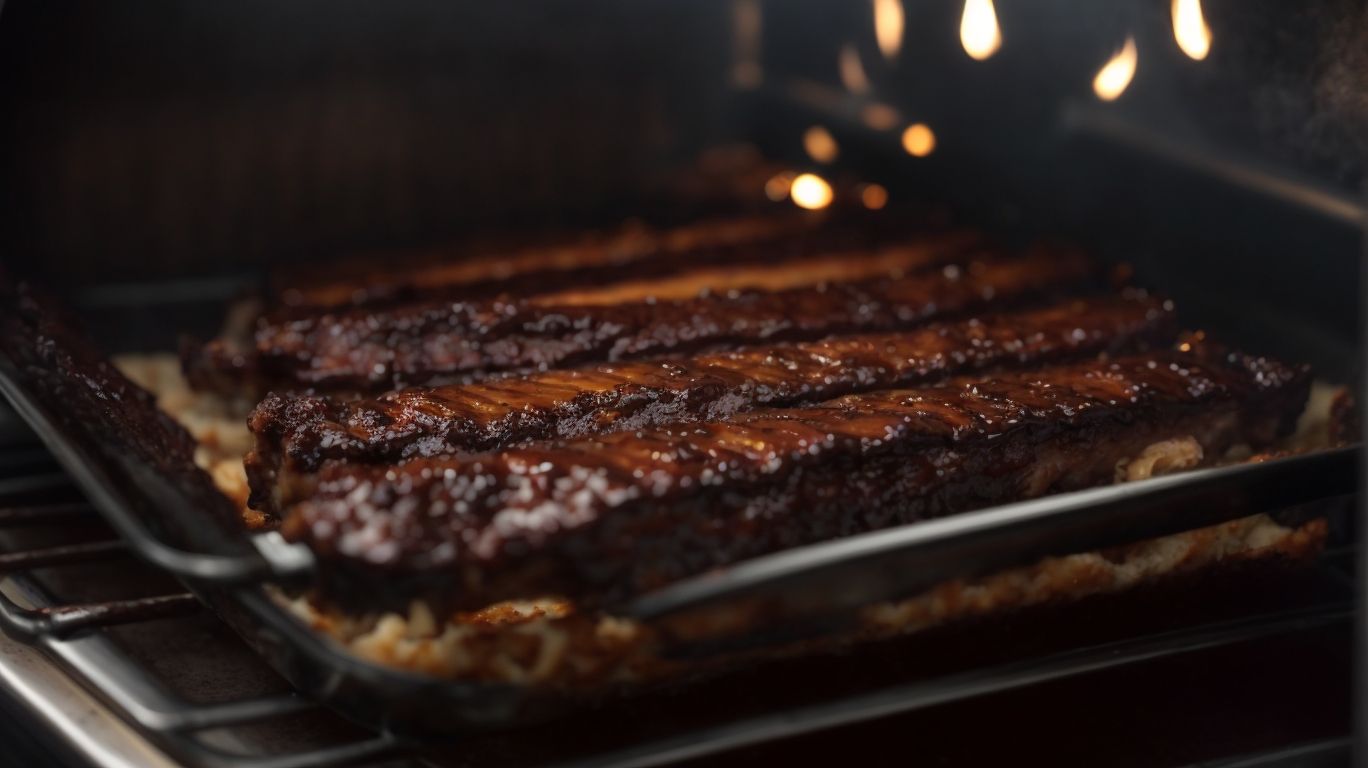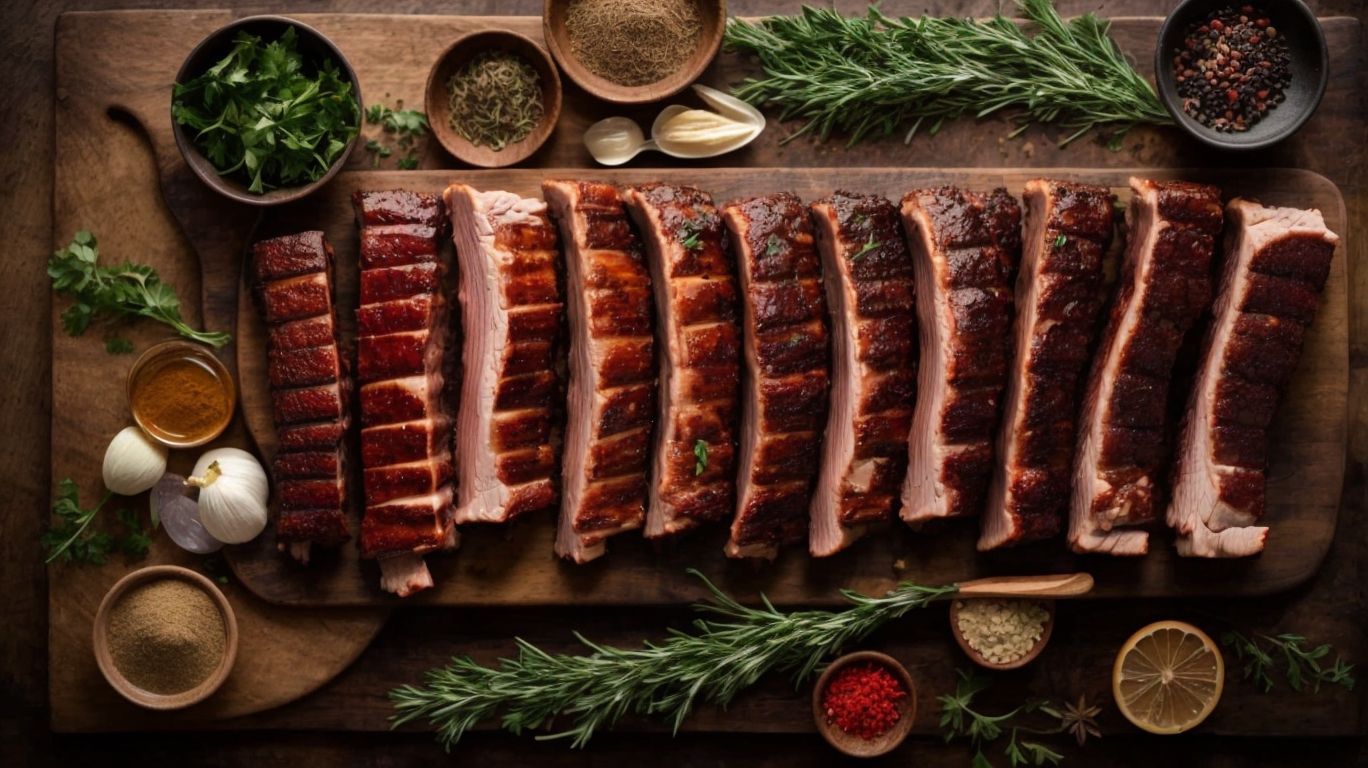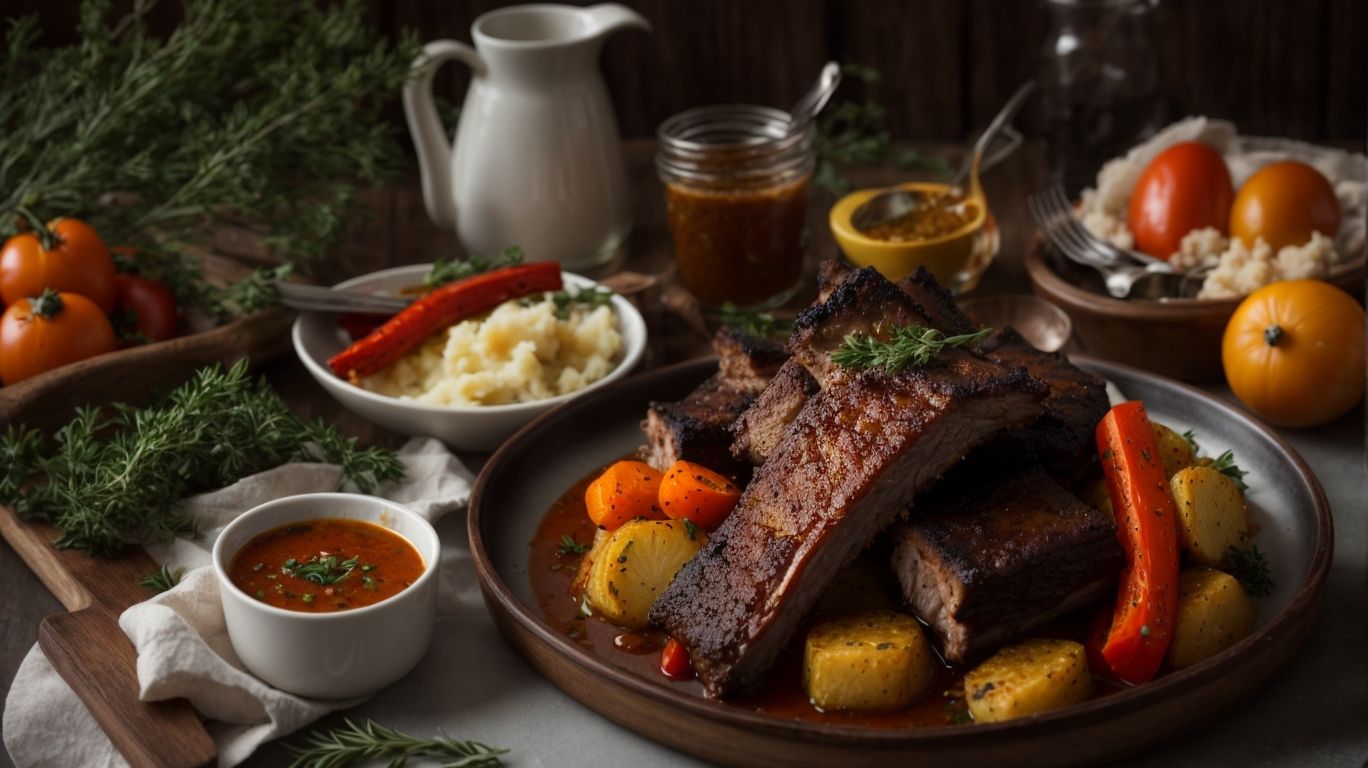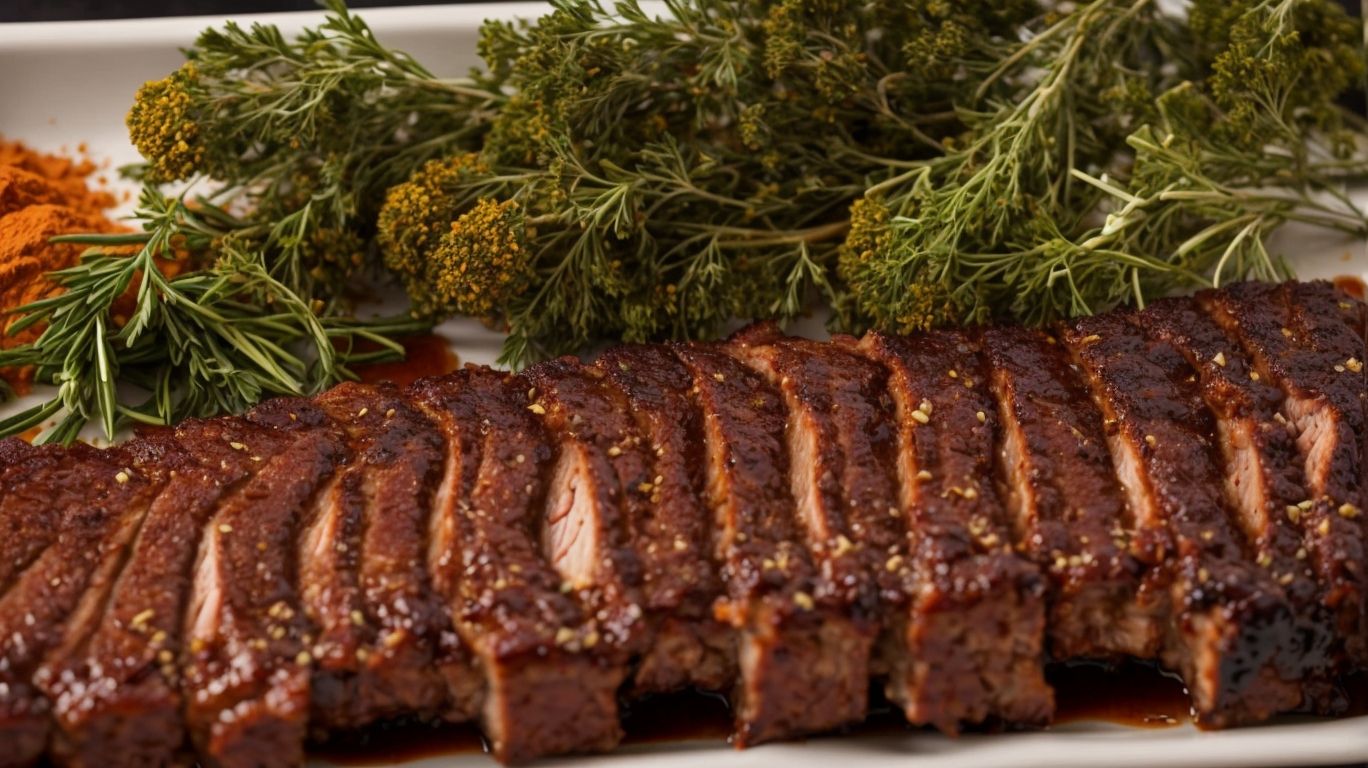How to Bake Ribs Without Bbq Sauce?
Are you looking for a healthier and more versatile way to enjoy delicious ribs?
In this article, we will explore the reasons why baking ribs without BBQ sauce can be a game-changer.
From choosing the right type of ribs to preparing and baking them to perfection, we will cover everything you need to know to create mouthwatering ribs without the need for sauce.
Join me, Chris Poormet, as we dive into the world of baking ribs like a pro!
Key Takeaways:
Why Bake Ribs Without BBQ Sauce?

Credits: Poormet.Com – Jeffrey Anderson
Baking ribs without BBQ sauce offers a healthier and more versatile cooking option for achieving exquisite flavors.
By opting for a sauceless approach, you reduce the sugar and calorie content typically found in BBQ sauces, making your meal a lighter alternative without compromising on taste. This method allows the natural flavors of the ribs to shine through, creating a more wholesome dining experience. Without being masked by a dominant sauce, you have the opportunity to experiment with various rubs, seasonings, and marinades to customize the flavor profile to your liking.
Healthier Option
Opting to bake ribs without BBQ sauce can result in a healthier dish without compromising on flavor and tenderness.
By omitting the sauce, you can focus on enhancing the natural flavors of the ribs and experimenting with different dry rubs. Spices such as paprika, garlic powder, onion powder, and brown sugar can be combined to create a flavorful crust that caramelizes during baking, adding depth and texture to the meat.
Cooking the ribs low and slow is key to achieving that fall-off-the-bone tenderness. By using a low temperature (around 250°F) and allowing the ribs to cook for a longer period, the collagen breaks down, resulting in a juicy and tender outcome.
Versatile Flavor Options
By baking ribs without BBQ sauce, you can explore a myriad of flavor options such as hickory-smoked, caramelized, and richly seasoned profiles.
When opting for dry rubs, you can infuse your ribs with a bold mix of spices like paprika, garlic powder, brown sugar, and cayenne pepper, creating a tantalizing crust that enhances the meat’s natural flavors.
The smoking process adds a depth of flavor as the meat slowly cooks over low heat, absorbing the essence of the wood chips, whether it’s mesquite for a robust taste or applewood for a sweeter note.
Another technique to elevate the taste is the caramelization of the meat’s sugars, where the natural sweetness intensifies, complementing the savory and smoky elements.
Choosing the Right Ribs for Baking

Credits: Poormet.Com – Gerald Jackson
Selecting the appropriate ribs, whether it’s baby back, spare ribs, or pork ribs, is crucial for a successful baking process.
In terms of baby back ribs, these are known for their tenderness and meatiness, making them a popular choice for baking. On the other hand, spare ribs have more fat content, which can add flavor during the baking process, but they require longer cooking times to become tender. It’s essential to marinate the ribs before baking to enhance their flavor and juiciness. Marinating with a blend of spices, herbs, and sauces can make a significant difference in the final taste. When opting for pork ribs, choosing between St. Louis-style ribs or country-style ribs can impact the overall flavor profile due to variations in fat content and meat quality.
St. Louis Style Ribs
St. Louis style ribs are a popular choice for baking due to their meaty texture and ideal slab size for marinating and seasoning.
These ribs are cut from the belly side of a hog after the spareribs are removed, resulting in a rectangular shape and uniform weight. The marbling in the meat provides a rich and juicy flavor when cooked. To enhance the taste, they are often marinated before being baked, and this process helps to tenderize the meat and infuse it with delicious flavors.
Due to their thickness, St. Louis style ribs are perfect for slow cooking methods like baking, which allows the flavors to develop and the meat to become fork-tender. The bones in these ribs add extra flavor to the dish, making them a favorite among barbecue enthusiasts.
Baby Back Ribs
Baby back ribs are renowned for their tenderness, juiciness, and ability to effortlessly fall off the bone when baked to perfection.
This cut of ribs comes from the loin area of the pig, known for its meaty yet lean composition, making it ideal for those who prefer a balance between meatiness and tenderness. The secret to achieving that coveted fall-off-the-bone texture lies in slow cooking at low temperatures, allowing the collagen to break down and the meat to become tender. To elevate the flavor profile, many grillmasters opt for a dry rub or a flavorful sauce, enhancing the natural juiciness of the ribs with a burst of delicious seasonings.
Spare Ribs
Spare ribs are a flavorful and versatile option for baking, offering opportunities for slow cooking, caramelization, and infusions of smoky hickory flavors.
When preparing spare ribs for baking, it’s important to select cuts that have a good ratio of meat to fat, as this will ensure tenderness and flavor. Slow cooking allows the meat to become tender and juicy, making it easy to remove from the bone.
Caramelization is a key step in achieving that savory-sweet flavor profile that pairs wonderfully with the rich taste of ribs. Incorporating hickory-smoked flavors can elevate the taste to a whole new level, adding a delightful smokiness that complements the meat perfectly.
Preparing the Ribs for Baking
Before baking, preparing the ribs involves essential steps like removing the membrane, applying dry rub, and ensuring proper cooking conditions.
To start, removing the membrane from the back of the ribs is crucial for allowing the flavors to penetrate the meat. This can be achieved by loosening a corner of the membrane with a knife and then using a paper towel for better grip to peel it off.
Next, applying a generous amount of dry rub is key to infusing the ribs with a flavorful blend of spices. A good dry rub typically consists of a mix of ingredients like brown sugar, paprika, garlic powder, salt, and pepper.
Once the dry rub is applied, tightly wrapping the ribs in aluminum foil helps to lock in moisture and ensure they cook evenly. This method also creates a steamy environment that enhances tenderness.
Removing the Membrane
A key step in rib preparation is removing the membrane to enhance tenderness and allow for better flavor absorption during baking.
This thin, translucent membrane covers the bone side of the ribs, and if left on, it can result in chewy and tough meat.
To effectively remove it, start by loosening a corner with a butter knife or your fingers. Once you have a good grip, slowly and steadily pull it off in one piece. This process not only improves the texture of the ribs but also helps spices and marinades penetrate the meat for a more flavorful outcome.
Seasoning the Ribs
Seasoning the ribs with a flavorful dry rub containing salt, pepper, garlic powder, and onion powder is essential for enhancing taste and texture.
When preparing ribs, the dry rub plays a crucial role in infusing the meat with layers of flavor. The combination of spices like paprika, cayenne, and brown sugar adds depth and complexity to the taste. By allowing the rub to penetrate the meat before cooking, it helps create a delicious crust that seals in juices, resulting in tender and succulent ribs. Properly seasoning with a balanced blend of ingredients ensures that every bite is packed with savory goodness, making your ribs a standout dish at any barbecue or gathering.
Marinating the Ribs (Optional)
Marinating the ribs with a homemade marinade can infuse additional flavors and tenderize the meat for a delightful baking outcome.
When preparing a marinade for ribs, consider combining acidic ingredients like vinegar, wine, or citrus juices to help break down the tough muscle fibers in the meat, making it more tender. Additionally, sweeteners such as honey or brown sugar can caramelize during cooking, adding a delightful glaze to the ribs. A blend of spices and herbs like garlic, paprika, thyme, or cumin can bring depth and complexity to the flavor profile. For optimal results, let the ribs marinate in the refrigerator for at least a few hours, or even overnight, to allow the flavors to permeate the meat thoroughly.
Baking the Ribs
The baking stage requires careful attention to oven temperature, cooking time, the use of foil, and optional basting for optimal rib texture and flavor.
When preparing ribs for baking, it’s crucial to preheat the oven to 275°F for a low and slow cook that ensures tender meat. Covering the ribs with foil during the initial baking period helps to retain moisture and tenderness while cooking. Typically, ribs should bake for about 2-2.5 hours at this temperature, but it’s essential to check for doneness by looking for meat that pulls away from the bone.
Oven Temperature and Time
Achieving the ideal balance of oven temperature and baking time is critical for ensuring that the ribs reach the desired level of tenderness and flavor.
When cooking ribs, precision in temperature control can make all the difference between tough and tender meat. Setting the oven to the precise temperature ensures that the meat cooks evenly and retains its natural juices for succulent results. Likewise, the baking duration plays a crucial role in developing the flavors and textures of the ribs. Whether you prefer fall-off-the-bone tenderness or a bit of chew, understanding the optimal baking times for different cuts of ribs is key to achieving that perfect balance.
Foil or No Foil?
Deciding whether to use foil during the baking process impacts factors such as caramelization, moisture retention, and the interaction of the dry rub with the meat.
When foil is used to wrap the ribs, it creates a steamy environment inside, which can help in retaining moisture and ensuring the meat stays tender. On the flip side, omitting foil can lead to better caramelization on the meat’s surface, enhancing the overall flavor profile. Without foil, the dry rub spices have a chance to form a delicious crust on the ribs, intensifying their taste and texture. Ultimately, the decision to use foil or not depends on the desired outcome, whether you prioritize a tender, moist result or a more charred, flavorful finish.
Basting the Ribs (Optional)
Opting to baste the ribs during baking with a flavorful sauce or spice rub can enhance moisture retention and impart additional layers of taste.
When basting the ribs, the process involves periodically coating them with the sauce or rub mixture. This not only helps in keeping the meat moist throughout the cooking process but also allows the flavors to seep into the meat gradually, resulting in a more delicious end product. Basting also aids in the development of a beautiful glaze on the surface of the ribs, adding an appealing visual element to your dish. It’s a simple yet effective technique that can significantly elevate the overall taste and presentation of your ribs.
Serving Suggestions

Credits: Poormet.Com – Ronald Gonzalez
When serving baked ribs, consider pairing them with a variety of sauces, complementary side dishes like cornbread, and other restaurant-quality accompaniments.
One key factor in enhancing the flavor of the baked ribs is the selection of sauces. Barbecue sauce is a classic choice, offering a tangy and smoky flavor that complements the rich meatiness of the ribs. For those looking for a spicy kick, consider offering a chipotle or habanero-based sauce to add some heat. A sweet and sticky glaze can also be a delightful option for those who prefer a sweeter taste profile.
In terms of side dishes, cornbread is a must-have accompaniment for baked ribs. The slightly sweet and crumbly texture of cornbread provides a perfect balance to the savory and meaty ribs. You can also consider serving classic sides like coleslaw, baked beans, or potato salad to round out the meal and offer a variety of flavors and textures.
To create a restaurant-quality dining experience at home, focus on presentation and attention to detail. Serve the ribs on a platter, garnished with fresh herbs or citrus zest for a pop of color and freshness. Set the table with quality dinnerware and utensils, dim the lights, play some soft music, and perhaps even light some candles to create a cozy and inviting ambiance for your guests to enjoy their meal.
Sauce Options for Serving
A selection of flavorful BBQ sauces can elevate the dining experience when serving baked ribs, enhancing taste profiles and caramelization.
When choosing the perfect sauce for your baked ribs, consider traditional options like sweet and tangy BBQ sauce, spicy chipotle BBQ, or smoky mesquite flavors. Each distinct sauce complements the richness of the ribs in its unique way.
To enhance the flavor further, you can experiment with adding ingredients such as honey, garlic, mustard, or even a splash of bourbon to your BBQ sauce. These additions can bring a depth of flavor and complexity to the dish.
Caramelization, a result of sugars in the sauce reacting with heat, plays a crucial role in developing a rich, savory taste on the ribs. Different types of sauces can create varying degrees of caramelization, impacting the overall taste and texture of the final dish.
Side Dish Suggestions
Pairing baked ribs with delectable side dishes like cornbread can complement the dish’s juiciness and enhance the overall flavor profile through caramelization contrasts.
In terms of selecting the perfect side dishes to serve with your succulent baked ribs, considering the rich and robust flavors of the meat is essential.
Cornbread
is a classic choice that offers a sweet and savory contrast to the savory ribs. The buttery texture of the cornbread perfectly balances the tender juiciness of the ribs, creating a harmonious combination that will satisfy even the most discerning palate.
Plus cornbread, other side dishes such as tangy coleslaw or creamy mashed potatoes can further elevate the dining experience. The tanginess of the coleslaw can provide a refreshing counterpart to the rich flavors of the ribs, while the creamy mashed potatoes offer a comforting and velvety texture that complements the meat’s juiciness.
Tips and Tricks for Perfectly Baked Ribs
Follow these expert tips and tricks to ensure your baked ribs achieve perfection, from using a meat thermometer to infusing a delightful smoky flavor.
In terms of using a meat thermometer for baking ribs, it is crucial to get the temperature just right. Aim for an internal temperature of around 190-203°F to ensure that the meat is tender and juicy. Remember, cooking times may vary depending on the thickness of the ribs, so always use the thermometer as your guide.
To enhance the moisture of your ribs while baking, consider using a method such as wrapping them in foil during part of the cooking process. This helps retain the natural juices and keeps the meat from drying out.
For that authentic and irresistible smoky flavor, try using a combination of wood chips, such as hickory or applewood, in your oven. Create a smoke packet with the chips and place it close to the heat source to infuse the ribs with a rich, smoky essence.
Using a Meat Thermometer
Utilizing a meat thermometer while baking ribs ensures precise temperature monitoring, leading to juicier and perfectly cooked meat.
When baking ribs, the consistency in temperature is crucial in achieving that ideal texture and flavor. With a meat thermometer, you can avoid undercooking or overcooking your ribs, as it allows you to accurately gauge when they are done. This not only enhances the taste but also ensures food safety by cooking the meat to the correct internal temperature.
Meat thermometers offer convenience and reliability in the cooking process, making it easier to achieve consistently delicious results every time you fire up the grill or oven for a rack of ribs. Whether you prefer baby back ribs, spare ribs, or St. Louis style, using a meat thermometer can significantly elevate your cooking game.
Adding Moisture to the Baking Process
Enhance the juiciness of baked ribs by incorporating moisture-boosting techniques like occasional basting and utilizing aluminum foil for moisture retention.
In terms of maintaining optimal moisture levels in your baked ribs, basting plays a crucial role. Regularly basting the ribs with flavorful liquids not only adds moisture but also infuses them with delicious flavors.
Wrapping the ribs in aluminum foil during the cooking process can help lock in moisture, preventing them from drying out. This technique creates a steamy environment around the ribs, ensuring they stay juicy and tender throughout the cooking process.
Adding a Smoky Flavor
Infuse your baked ribs with a delightful smoky flavor by incorporating smoked elements like hickory wood chips or flavoring agents during the cooking process.
Adding a smoky essence to your ribs can elevate the taste to a whole new level. For hickory wood chips, pre-soak them in water for at least 30 minutes before using them in your smoker or grill. The moisture from the chips helps with smoke production and prevents them from burning too quickly, imparting a balanced smoky flavor to the meat. Another option is to include smoked ingredients like paprika, cumin, or liquid smoke in your marinade or dry rub for an intensified smokiness that permeates the ribs. Experimenting with different combinations of these smoky elements can help you tailor the flavor profile to your liking, creating a truly mouthwatering dish.
Frequently Asked Questions
1. How to Bake Ribs Without Bbq Sauce?
While bbq sauce is a popular choice for baking ribs, there are other delicious alternatives. Here’s how you can bake ribs without using bbq sauce.
2. What is a good substitute for bbq sauce when baking ribs?
You can use a homemade dry rub to season your ribs or try a savory marinade, such as teriyaki or honey mustard, for a delicious alternative to bbq sauce.
3. Can I still achieve a smoky flavor without using bbq sauce?
Yes, you can! Try adding a few drops of liquid smoke to your dry rub or marinade to give your ribs that delicious smoky flavor.
4. How can I ensure my ribs are tender and juicy without using bbq sauce?
Slow and low is the key. Baking the ribs at a low temperature (around 250°F) for a longer period of time (3-4 hours) will result in tender and juicy ribs without the need for bbq sauce.
5. What are some other flavor combinations I can try when baking ribs without bbq sauce?
You can experiment with different herbs and spices, such as rosemary, thyme, or cumin, to create unique flavor profiles for your ribs. You can also try adding a splash of citrus juice for a tangy twist.
6. Are there any additional tips for successfully baking ribs without bbq sauce?
Make sure to wrap your ribs tightly in foil before baking to retain moisture and add a bit of liquid, such as apple juice or beer, to the foil packet for added flavor. You can also baste the ribs with butter or olive oil during the baking process to keep them from drying out.

